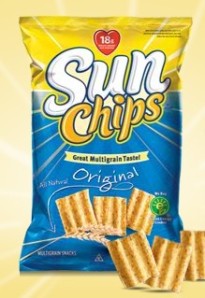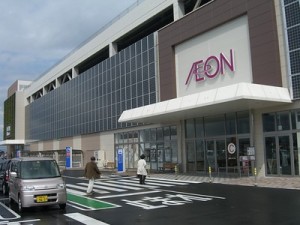
Solar panels cover an Aeon shopping mall in Yonago, Japan (photo by Aaron Dalton)
I recently returned from a few weeks in Japan.
Naturally, during my trip, I kept my eyes open for the latest and greatest eco-news to share with 1GreenProduct.com readers. Here’s what I found:
1) At a remodeled Aeon shopping mall near the western city of Yonago, I found huge sections of exterior wall had been lined with solar panels. As a result, practically the entire building functioned as a solar collector. Other parts of the mall structure were covered in “living wall” type greenery. This eco-minded mall even had mini windmills perched on poles in the parking lot. The mall’s remodeling had let in more natural light, allowing for a reduction in energy spent on artificial lighting.
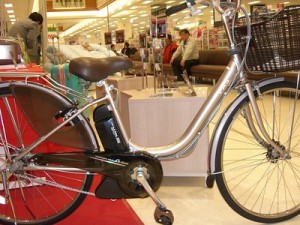
"Testing" this electric bicycle meant sitting on it (photo by Aaron Dalton)
Meanwhile, I found an electric bike on display at the mall. Having never had a chance to actually ride one before, I hoped to be able to test it out. In one of those comical cases of misunderstanding that often occurs abroad, the salesperson assured me that I could indeed test the bike. But I soon found this meant only that I could sit on the bike as long as I remained still and did not pedal it anywhere. This didn’t really end up being a very useful test of the bike’s electric functionality.
America has giant shopping malls. America has a lot of parking lots. Surely we could be retrofitting some of our shopping centers with solar panels and windmills as Aeon has done in Yonago. All it takes is willpower and imagination.
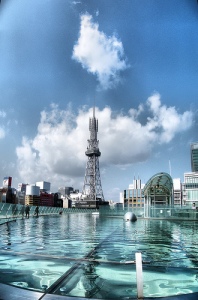
Looking at the Nagoya skyline from the water-covered roof of Oasis 21 (photo by Emran Kassim)
2) In the city of Nagoya, I took a break from seeing castles and museums to visit Oasis 21. This transit center / park / shopping mall / futuristic spaceship-style structure located in the city’s Sakae shopping district certainly makes an impression.
What makes it eco? Well, the roof of Oasis 21 consists of a very shallow oval pool of water. The water reflects heat, cooling the ground-level plaza and the open-air below-ground shopping center.
Even better, the roof also collects rain water, which it then uses to irrigate the plantings in the park below.
Plus, it makes for a pretty cool place for couples, families and businesspeople on a lunch break to come sit, contemplate the reflecting pool and gaze at the TV Tower and the rest of Nagoya’s high-rise skyline.
I like Oasis 21’s boldness. There are surely less expensive ways to collect rain water, but Oasis 21 places Green ideas on center stage in one of the city’s trendiest districts, showing that eco can be sexy, eco can be dramatic and eco can be architecturally beautiful.
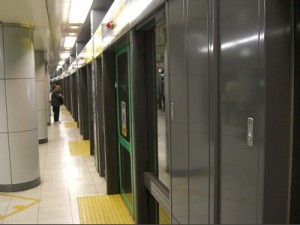
New Tokyo Metro line with protective clear walls between platform and tracks (photo by Aaron Dalton)
3) I won’t dwell much on the differences between Tokyo’s mass transit systems and the subway system that I endure in my hometown of New York City. To think too much on the topic would probably reduce me to tears.
In brief, the Tokyo metro is clean, modern, unoffensive, safe, smooth and quiet.
The New York subway is none of those things.
But what I really would like to draw attention to in this adjacent photograph is the fact that some of the newer Tokyo metro stations have walls of glass or plexiglass (not sure of the exact material) separating the platform from the tracks. When the train arrives, the doors of car line up with sliding doors in the glass walls and both open simultaneously, allowing passengers to exit and board the trains.
As a result, I believe that it is practically impossible to be pushed in front of a train in the Tokyo Metro.
In New York, on the other hand, the narrow and crowded platforms present a definite hazard, particularly during rush hour when a few inches or a shove from behind is all that separates a passenger from the fetid tracks and injury or death beneath an onrushing train.
Given the general state of dilapidation and disrepair in the NY subway, it seems highly unlikely that protective glass doors like these will be installed anytime soon. This is a sad commentary on the extent to which America has fallen behind in mass transit best practices in comparison not only with Japan, but with other countries like France where such systems are being installed.
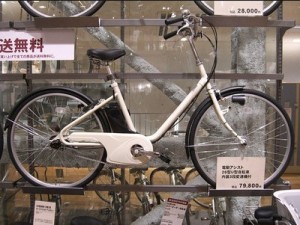
The Muji e-bike (photo by Aaron Dalton)
4) Finally, not quite satisfied with my brief test of the e-bike back in Yonago, I found an opportunity to rent an electric bike in Tokyo at a Muji store.
For around $15 and a deposit, I had the e-bike for the entire day. This was my first time ever using an electric-assist bike and frankly it was amazingly fun.
The bike was electric-assist – meaning that it would not move unless the rider pedaled. But pedaling up even the steepest hills was no problem with the electric motor on maximum assist. On flatter terrain, I left the electric assist on low or medium settings in order to stretch out the battery life.
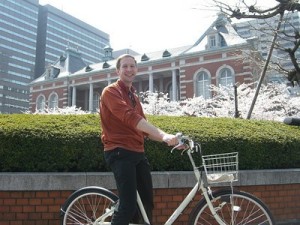
Riding the Muji e-bike through Tokyo during cherry blossom season
Using an e-bike feels like someone is giving you a gentle push from behind, like when you were first learning to ride a bicycle. The freedom and speed that an e-bike provides is exhilarating, almost giddy.
At the same time, you do still get some exercise pedaling an e-bike around town for a few hours. But what would have been exhausting without electric assist was merely a nice bit of exercise with the motor providing support.
Incidentally, in Tokyo, bicyclists are allowed to use the sidewalks. This made for some extremely interesting close-quarters maneuvering when the office crowds emerged for the lunchtime rush.
(Oh, another cool thing about the Muji e-bike, which apparently is true of all sorts of bikes sold in Japan, is that it has an integrated lock built right into the bike. Turn and take the key with you when you dismount and a bolt shoots through the wheel, making it impossible for anyone to pedal off with your bike. As a result, no one has to carry around a chain or even a lock to secure their bike to a post or tree. Very convenient and easy. Would love to see this feature on bikes sold in the U.S.! Perhaps it is available here already on some models?)
The Muji bike retailed for approximately $800. Unfortunately, Muji stores in the States don’t seem to carry the e-bike, but you can find various electric bikes if you shop around on the Internet or perhaps at your local bike shop.
Amazon sells some e-bikes for reasonable prices, but the $372 eZip Trailz bike appears to use an old-fashioned sealed lead acid battery, whereas newer e-bikes are using lighter and slimmer lithium ion batteries. The Ohm e-bike looks pretty cool, but apparently goes for around $2000.
Based on my experience in Tokyo, I believe that an e-bike could be a real commuting option for people who live fairly close to work (say within 10 miles) and have a relatively safe biking route available. Given the importance of having a comfortable, safe and enjoyable ride, you might want to go to a local bike shop and try out a couple e-bike models in person. If your shop doesn’t carry an e-bikes yet, encourage the owner to start bringing e-bikes to the market.
I’m a believer. I think once people get a chance to try out an e-bike, they’ll be hooked.
 Over the past year, I’ve tried to share thoughts and analysis on some of my favorite eco-friendly products and places.
Over the past year, I’ve tried to share thoughts and analysis on some of my favorite eco-friendly products and places.

